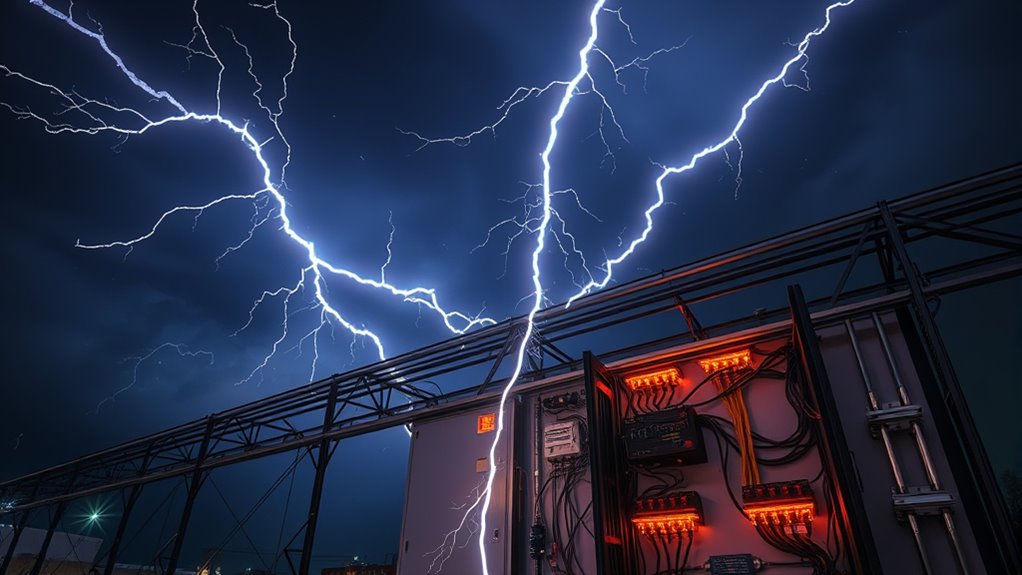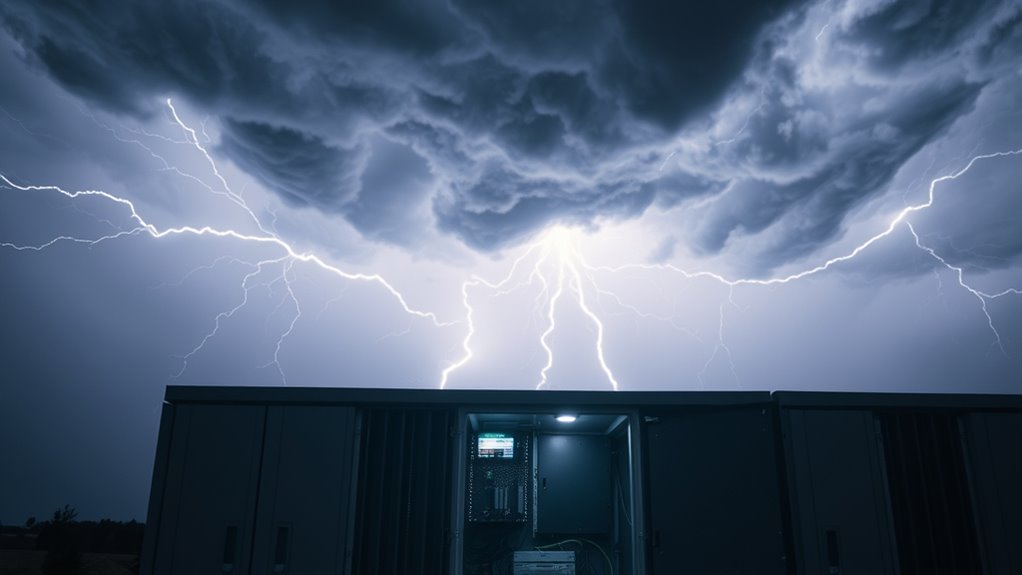To safeguard your edge automation from lightning strikes, focus on installing proper surge protective devices (SPDs) at key points like service entrances and critical equipment. Make certain your system is well-grounded and bonded to safely direct lightning energy into the earth. Use shielding, organize cables properly, and incorporate redundancies to minimize damage. Regular maintenance and monitoring further strengthen your defenses. Keep exploring how these strategies can keep your systems safe during thunderstorms.
Key Takeaways
- Install surge protective devices (SPDs) near sensitive edge automation equipment and at main power entry points.
- Ensure proper grounding and bonding to safely direct lightning energy away from electronics.
- Use shielding, insulated cables, and organized wiring to prevent electromagnetic interference and surges.
- Regularly inspect, test, and maintain SPDs, grounding systems, and cables for optimal protection.
- Incorporate backup power solutions and real-time monitoring to enhance system resilience against lightning-induced surges.
Understanding Lightning-Induced Surges and Their Impact

Lightning-induced surges occur when a lightning strike nearby causes a sudden spike in electrical voltage within power lines or electronic systems. This rapid increase can overwhelm your devices, damaging circuits or causing data loss. When lightning strikes close, the electrical energy travels through power and communication lines, creating a high-voltage pulse. This surge can bypass your regular power supply protections, reaching sensitive equipment in edge automation systems. The impact isn’t limited to immediate failure; it can weaken components over time, reducing their lifespan. Without proper safeguards, your equipment becomes vulnerable to these unpredictable voltage spikes. Understanding how these surges occur helps you recognize the importance of installing surge protection devices and grounding systems to defend your electronics against lightning’s unpredictable power. Proper planning can also involve beneficial strategies to mitigate the effects of such surges and extend the longevity of your equipment.
Assessing Vulnerable Components in Edge Automation Systems

To safeguard your edge automation systems, you need to identify which components are most vulnerable. Focus on sensitive hardware that can easily be damaged, power supplies that lack proper surge protection, and communication interfaces prone to interference. Addressing these points helps ensure your system remains resilient against lightning-induced events. Additionally, understanding the importance of color accuracy in your system’s visual components can prevent misinterpretations and failures.
Sensitive Hardware Identification
Identifying vulnerable components in edge automation systems is essential for safeguarding sensitive hardware against lightning strikes. Knowing which parts are most at risk helps you implement targeted protections. Start by evaluating your control boards, sensors, communication interfaces, and power modules, as these are often most exposed. Additionally, understanding the paint sprayer technology used in your equipment can help prevent electrical surges from causing damage.
Power Supply Vulnerabilities
Power supplies are critical components in edge automation systems, providing the necessary voltage and current to keep equipment operational. However, they are vulnerable to power surges, spikes, and voltage fluctuations caused by lightning or grid issues. These disturbances can damage internal components, leading to system failures or reduced lifespan. Overvoltage events can cause immediate component burnout, while sustained fluctuations may degrade sensitive electronics over time. You must assess your power supply’s capacity to handle sudden surges and ensure proper grounding and shielding. Using surge protectors, uninterruptible power supplies (UPS), and voltage regulators can mitigate risks. Regular maintenance and inspections help identify early signs of vulnerability, allowing you to address issues before they cause costly downtime or equipment damage. Protecting your power supply is vital for reliable edge automation performance, especially considering the threats posed by global espionage tactics that might target critical infrastructure vulnerabilities.
Communication Interface Risks
Are your communication interfaces in edge automation systems prepared to withstand environmental and electrical threats? These components are often the first to face lightning surges, electromagnetic interference, or voltage spikes. To assess their vulnerability, consider these key areas:
- Connectors and Cables: Loose or unshielded connections can allow surges to penetrate easily.
- Network Ports: Unprotected Ethernet or serial ports are prime entry points for electrical disturbances.
- Wireless Modules: Susceptible to electromagnetic interference if not properly shielded.
- Signal Converters: Inadequate grounding or poor insulation can lead to damage during surges.
- Regular inspection, proper shielding, and surge protection devices can markedly reduce these risks, ensuring your communication interfaces remain reliable and safe against lightning threats. Additionally, understanding the vulnerable components in your system helps prioritize protective measures effectively.
Grounding and Bonding Strategies for Effective Protection

Effective grounding and bonding are essential for protecting electronic systems from lightning-induced surges. Proper grounding ensures that lightning energy is safely directed into the earth, reducing the risk of damaging voltage spikes. Bonding connects all metallic components, creating a unified electrical path that minimizes potential differences during a surge. To optimize protection, use appropriately sized conductors and low-impedance connections, ensuring reliable current flow. Keep grounding systems separate from other electrical grounds to avoid interference. Regularly inspect and maintain connections to prevent corrosion or loose bonds. Implement a single, low-resistance grounding point for your entire system, reducing the chance of dangerous voltage gradients. Additionally, understanding Ford Tuning principles can help optimize your electrical system setup for enhanced surge protection. These strategies help you create a robust defense, safeguarding your electronic assets from lightning strikes and surges.
Installing Surge Protective Devices (SPDs) for Critical Equipment

To safeguard your critical equipment effectively, you need to install the right surge protective devices in the correct locations. Regular maintenance and testing ensure these devices continue to work when you need them most. Paying attention to proper placement and upkeep helps you prevent costly damage from lightning strikes. Incorporating essential oils for equipment safety in your maintenance routine can also promote a safer electrical environment.
Proper SPD Placement
Proper placement of surge protective devices (SPDs) is essential to guarantee critical equipment remains protected from voltage surges. To maximize effectiveness, you should consider these key points:
- Install SPDs as close as possible to the equipment they protect, ideally at the main distribution panel.
- Place SPDs at the service entrance to block surges before they enter your system.
- Use additional SPDs at branch panels for sensitive equipment further down the line.
- Ensure SPDs are grounded properly to direct surge energy safely into the earth.
- Leveraging AI-driven solutions can enhance the precision of SPD placement by analyzing surge patterns and system vulnerabilities.
Proper placement minimizes surge energy reaching your equipment, reducing damage risk. Avoid placing SPDs too far from the protected device or in locations prone to environmental damage, like damp areas. Correct placement is crucial for reliable surge protection.
Maintenance and Testing
How can you guarantee your surge protective devices (SPDs) continue to provide reliable protection? Regular maintenance and testing are essential. Start by inspecting SPDs for signs of wear, corrosion, or damage every few months. Check connections to ensure they’re tight and free of debris. Use testing equipment to verify that the devices still trip at their designated surge levels. Replace any SPDs that show signs of deterioration or fail testing. Document all inspections and test results for future reference. Staying informed about SPDs’ lifespan and their proper maintenance schedules helps ensure ongoing protection. Consistent maintenance prevents unnoticed failures that could leave critical equipment vulnerable during a storm. Remember, SPDs degrade over time, so proactive testing and replacement are key to maintaining effective lightning protection and avoiding costly downtime.
Designing Robust Cabling and Shielding Solutions

Designing robust cabling and shielding solutions is essential for protecting electronics from lightning-induced surges and electromagnetic interference. Proper cabling reduces vulnerability by minimizing noise and ensuring reliable data transfer. Shielding acts as a barrier, preventing external electromagnetic fields from disrupting signals. To optimize your setup:
- Use shielded cables with grounded braids or foil to block interference.
- Keep cables short and organized to reduce exposure to external surges.
- Separate power and signal cables to prevent cross-interference.
- Connect shields at one end only to avoid ground loops that can amplify noise.
- Incorporate well-designed shielding techniques to further enhance system protection against electromagnetic disturbances.
Implementing these practices helps maintain system integrity and prevents costly damage. Remember, thoughtful cabling and shielding are your first line of defense against lightning and electromagnetic disruptions.
Implementing Proper System Layouts and Redundancies

Effective system layouts and redundancies build on solid cabling and shielding by guaranteeing continuous operation and minimizing downtime. You should organize your equipment to optimize signal flow, avoid interference, and facilitate easy maintenance. Redundant paths and backup components help keep your system running if one element fails. Consider implementing dual power supplies and network routes for critical devices. Proper placement reduces electromagnetic interference and simplifies troubleshooting. Use the following table to guide your layout strategy:
| Aspect | Best Practice |
|---|---|
| Physical Arrangement | Keep sensitive devices separated from power lines |
| Power Supply | Incorporate backup power sources |
| Network Routing | Use redundant pathways for critical connections |
| Shielding | Shield cables and enclosures to prevent interference |
| Maintenance Accessibility | Arrange components for easy access |
This approach guarantees your system’s resilience and operational continuity.
Maintenance and Monitoring to Ensure Continuous Defense

Regular maintenance and vigilant monitoring are essential to keep lightning protection systems operational and ready to respond to threats. Without regular checks, components can degrade or fail, leaving your equipment vulnerable. To maintain peak performance, follow these steps:
- Inspect grounding connections regularly to ensure they’re secure and corrosion-free.
- Test surge protection devices periodically to verify they activate during a strike.
- Clean lightning rods and conductors to prevent buildup that can impair functionality.
- Use monitoring systems that provide real-time alerts for any system anomalies or damages.
Frequently Asked Questions
How Often Should Surge Protection Devices Be Inspected or Replaced?
You should inspect surge protection devices at least once a year to guarantee they’re functioning properly. Replace them immediately if they show signs of damage, wear, or have absorbed a surge that exceeds their capacity. Regular inspections help maintain ideal protection for your electronics and automation systems. If your environment experiences frequent thunderstorms or power fluctuations, consider inspecting more often to keep your equipment safe and reliable.
Can Lightning Surges Affect Wireless or Remote Edge Devices?
Lightning surges can definitely affect your wireless or remote edge devices. They can cause data loss, hardware damage, or system failures. To protect your devices, guarantee surge protectors are in place, regularly inspect and replace them, and consider installing lightning arresters. Keep your systems grounded and stay vigilant during thunderstorms. By taking these steps, you minimize the risk of lightning-induced damage and maintain reliable, secure operations.
Are There Industry Standards Specific to Lightning Protection in Automation?
Yes, there are industry standards specific to lightning protection in automation. You should follow guidelines like IEC 62305, which covers lightning protection measures, and IEEE standards for surge protection. These standards help you design systems that mitigate lightning risks effectively. By adhering to them, you guarantee your automation equipment stays safe, reduces downtime, and maintains operational integrity even during severe weather conditions.
What Are the Costs Associated With Implementing Comprehensive Lightning Protection?
Implementing thorough lightning protection can cost anywhere from a few thousand to tens of thousands of dollars, depending on your system’s size and complexity. You’ll need to invest in lightning rods, grounding systems, surge protectors, and regular maintenance. While the upfront costs seem high, these measures save you money long-term by preventing expensive equipment damage and minimizing downtime. Proper planning ensures your automation remains safe and operational during thunderstorms.
How Does Climate Influence Lightning Risk and Protection Strategies?
Climate acts like a weather roulette wheel, influencing your lightning risk and protection strategies. In storm-prone areas, you face higher chances of lightning strikes, requiring robust grounding and surge protection. Conversely, milder climates may need less intensive measures. You must tailor your defenses based on local weather patterns, ensuring your equipment stays safe. Staying alert to climate shifts helps you adapt your approach, keeping your automation secure and resilient against lightning’s unpredictable power.
Conclusion
By taking these lightning protection steps, you build a fortress around your edge automation systems, shielding them from nature’s fierce tempests. Remember, a well-protected system isn’t just about avoiding damage—it’s about ensuring your operations run smoothly like a well-oiled machine, no matter how stormy the skies get. Stay vigilant, maintain your defenses, and let your automation stand tall like a lighthouse guiding ships safely through the storm.









